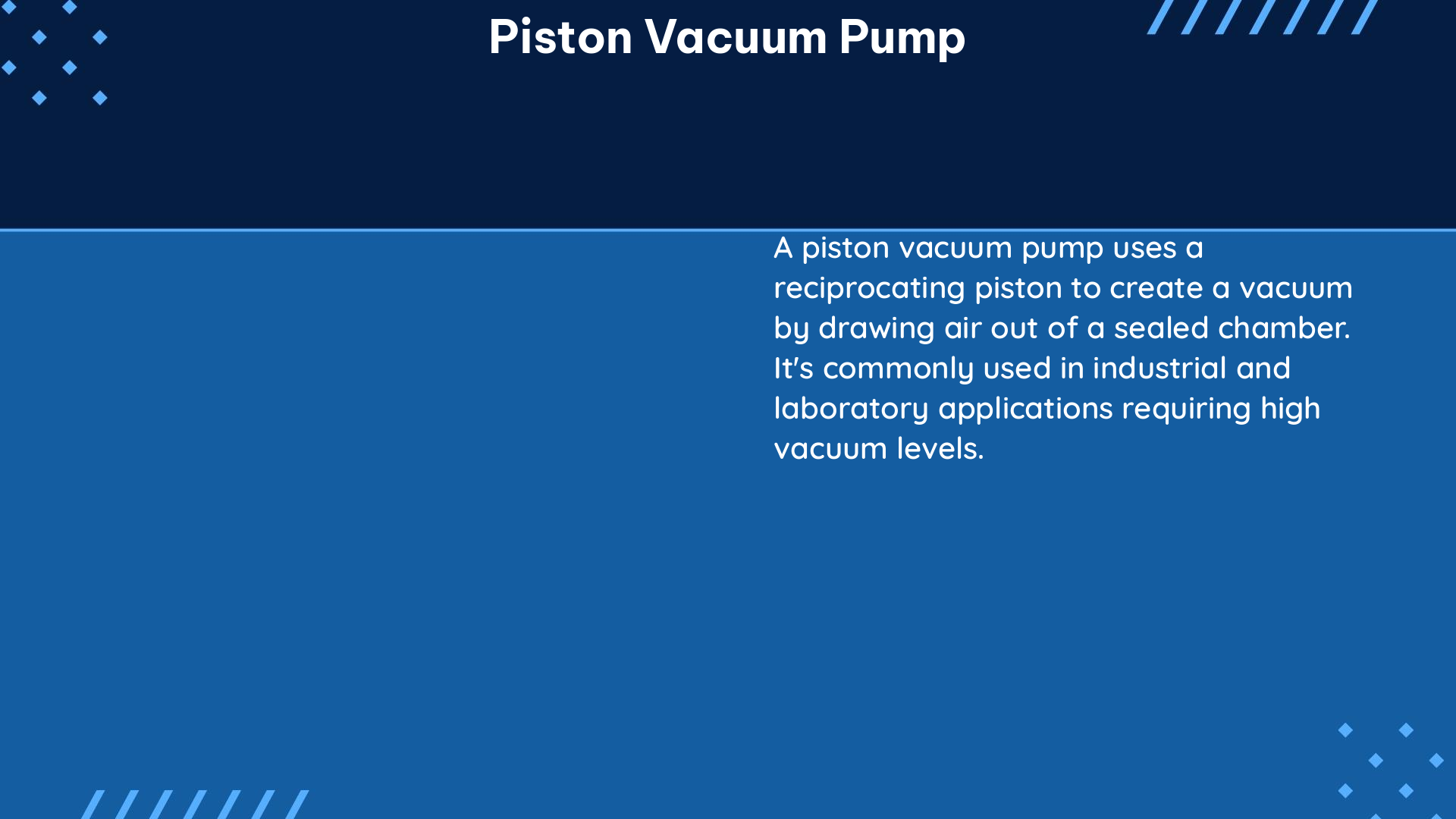Piston vacuum pumps are essential components in various applications, including automotive, industrial, and scientific settings. They generate vacuum by using a piston to draw gas or air into a chamber and expel it out, thereby reducing the pressure inside the chamber. This comprehensive guide will delve into the technical details and quantifiable data points specific to piston vacuum pumps, providing you with a valuable resource for understanding and optimizing their performance.
Pumping Speed: The Measure of Efficiency
Pumping speed, measured in liters per minute (LPM), is a crucial parameter that determines the efficiency of a piston vacuum pump. The pumping speed of these pumps can range from a few LPM to hundreds of LPM, depending on the size and design of the pump. For instance, a small piston vacuum pump designed for automotive applications may have a pumping speed of around 10-20 LPM, while a larger industrial-grade pump can reach speeds of 500 LPM or more.
Ultimate Vacuum: Reaching the Lowest Pressure

The ultimate vacuum, also known as the base pressure, is the lowest achievable pressure in a vacuum system. For piston vacuum pumps, the ultimate vacuum can range from a few millibars (mbar) to a few microns of mercury (µmHg), depending on the pump’s design and performance. High-end piston vacuum pumps can reach ultimate vacuums as low as 0.1 µmHg, making them suitable for applications that require extremely low pressures, such as in scientific research or semiconductor manufacturing.
Compression Ratio: Balancing Inlet and Outlet Pressures
The compression ratio is the ratio of the inlet pressure to the outlet pressure of a vacuum pump. For piston vacuum pumps, the compression ratio can range from a few tens to several thousands, depending on the pump’s design and performance. A higher compression ratio indicates the pump’s ability to efficiently evacuate air or gas from the system, making it suitable for applications that require a significant pressure difference between the inlet and outlet.
Flow Capacity: Handling the Volume of Gas
Flow capacity, measured in liters per minute (LPM), is the volume of gas that a vacuum pump can handle per unit time at a specific pressure difference. For piston vacuum pumps, the flow capacity typically ranges from a few LPM to hundreds of LPM, depending on the size and design of the pump. High-flow piston vacuum pumps are often used in applications that require the rapid evacuation of large volumes of gas, such as in industrial processes or vacuum chambers.
Power Consumption: Balancing Performance and Efficiency
Power consumption is the amount of electrical power that a vacuum pump requires to operate. For piston vacuum pumps, the power consumption can range from a few watts to several kilowatts, depending on the size and design of the pump. Energy-efficient piston vacuum pumps are designed to minimize power consumption while maintaining high performance, making them suitable for applications where energy usage is a critical factor.
Operating Temperature: Withstanding the Heat
The operating temperature is the range of temperatures at which a vacuum pump can operate safely and efficiently. For piston vacuum pumps, the operating temperature typically ranges from a few degrees Celsius to several hundred degrees Celsius, depending on the pump’s design and performance. High-temperature piston vacuum pumps are often used in applications that involve elevated temperatures, such as in the semiconductor industry or in certain chemical processes.
Dimensions and Weight: Considerations for Installation and Mobility
The dimensions and weight of a piston vacuum pump are important factors to consider when selecting a pump for a specific application. The size and weight of the pump can affect its ease of installation, mobility, and integration with other system components. Compact and lightweight piston vacuum pumps are often preferred in applications where space is limited, such as in automotive or portable equipment.
In addition to these quantifiable data points, it’s essential to consider the technical specifications of piston vacuum pumps when selecting a pump for a specific application. These specifications may include the pump’s materials of construction, lubrication requirements, noise levels, and maintenance requirements.
By understanding the technical details and quantifiable data points of piston vacuum pumps, you can make informed decisions when selecting and optimizing these critical components for your applications.
Reference:
- Fundamentals of Vacuum Technology
- OM61X Piston Vacuum Pump Science Project
- High Vacuum Pumps – Leybold

The lambdageeks.com Core SME Team is a group of experienced subject matter experts from diverse scientific and technical fields including Physics, Chemistry, Technology,Electronics & Electrical Engineering, Automotive, Mechanical Engineering. Our team collaborates to create high-quality, well-researched articles on a wide range of science and technology topics for the lambdageeks.com website.
All Our Senior SME are having more than 7 Years of experience in the respective fields . They are either Working Industry Professionals or assocaited With different Universities. Refer Our Authors Page to get to know About our Core SMEs.